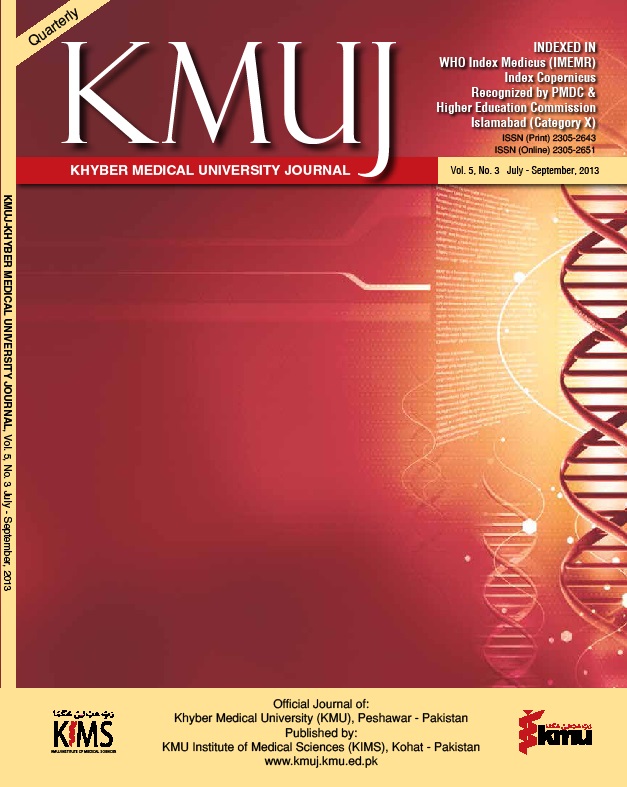EFFECT OF FIT –DELIVERY INTERVAL ON MATERNAL AND FETAL OUTCOME IN ECLAMPTIC PATIENTS
Main Article Content
Abstract
Objective: To determine the effect of fit-delivery interval on maternal and fetal outcome in antenatal eclamptic patients in our set up.
Methodology: This study was conducted at Hayatabad Medical Complex Peshawar, Pakistan. All antenatal patients presenting with eclampsia from January 2011 to December 2012 were retrospectively analyzed for effect of fit-delivery interval on maternal outcome (mortality, ICU admission) and fetal outcome (meconium stained liquor, low Apgar score, still birth, neonatal ICU admission and early neonatal death). Postnatal eclamptic patients were excluded from the study. Fit-delivery interval was calculated in hours. Data were analyzed by using SPSS version 16.
Results: Out of 8558 obstetric patients, 32 (0.37%) antenatal women had eclampsia. The mean age of the patients was 24±5.36 years. Most of the patients were young (80%) and primigravida (62.4%). The mean gestational age was between 36-40 weeks. There was no maternal mortality. Three (p=0.083) patients who delivered in >15 hours after the onset of fits were admitted in the intensive care unit. Neonates who were delivered within 15 hours of onset of fits had better fetal outcome. Meconium stained liquor (12.5%, p=0.023), low Apgar score (21.87%, p=0.001) and neonatal ICU admissions (12.5%, p =0.044) were found to be statistically significant. While stillbirth (9.37%, p =0.083) and neonatal death (6.89%, p=0.161) were not statistically significant.
Conclusion: Fit-delivery interval of up to 10-15 hours had good maternal and fetal outcome. Timely referral to tertiary care hospital and timely delivery of eclamptic patients is recommended to improve the maternal and fetal outcome.
Article Details
Work published in KMUJ is licensed under a
Creative Commons Attribution 4.0 License
Authors are permitted and encouraged to post their work online (e.g., in institutional repositories or on their website) prior to and during the submission process, as it can lead to productive exchanges, as well as earlier and greater citation of published work.
(e.g., in institutional repositories or on their website) prior to and during the submission process, as it can lead to productive exchanges, as well as earlier and greater citation of published work.
References
World Health Organization. Trends in
Maternal Mortality: 1990 to 2008: Geneva:
WHO, 2010. [Cited on April 02, 2013].
Available at: http:/ whqlibdoc.who.int/publication/
/9789241500265_eng.pdf.
Vigil-De Garcia P. Maternal death due to
eclampia and HELLP syndrome. Int J Gynaecol
Obstet 2009; 97 (4):90-4.
Zwart JJ, Richters A, Ory F, deVries JI,
Bloemenkamp KW, van Roosmalen J: Eclampsia
in the Netherland. Obstet Gynecol
;112: 820-31.
Almerie MQ, Matar H, Almerie Y. A20
years (1989-2008) audit of maternal
mortality in Damascus, Syria. Int Gynaecol
Obstet 2011; 112: 70-1.
Goldenberg RL, McClure EM, MacGuire,
Kamath BD, Jobe AH. Lesson for low-income
regions following the reduction in
hypertension related maternal mortality
in high-income countries. Int J Gynecol
Obstet 2011; 113: 91-5.
Ghazal-Asward S, Badrinath P, Sidky I,
Abdul-Razak, Davison J. Mirghani HM, et
al: Confidential enquiries into maternal
mortality in the united Arab emirates:
A feasibility study. J obstet Gynaecol Res
; 37: 209-14.
Allen VM1, Campbell M, Carson G, Fraser
W, Liston RM, Walker M, et al; Maternal
mortality and severe maternal morbidity
surveillance in Canada. J Obstet Gynaecol
Can 2010; 32: 1140-1146.
World Health Organization. Neonatal and
perinatal mortality: country, regional and
global estimates.Geneva: World Health
Organization; 2006.
Stanton C, Lawn JE, Rahman H, Wilczynska-
Ketende K, Hill K. Stillbirth rates: delivering
estimates in 190 countries. Lancet
; 367: 1487-94.
Moore PJ, Munoz WP. Eclampsia in the
black population of the Natal midlands. S
Afr Med J 1985; 67: 597-9.
Adamu AN, Ekele BA, Ahmed Y, Mohammad
BA, Isezue SA, Abdullahpi AA. Pregnancy
outcome in women with eclampsia
at a tertiary centre in northern Nigeria. Afr
J Med Sci 2012; 41(2): 211-9.
Maharaj B, Moodley J. Management of
hypertension in pregnancy. Cont Med
Educ 1991; 12: 1581-9.
Von Dadelszen P1, Payne B, Li J, Ansermino
JM, Broughton Pipkin F, Côté AM, et al.
Prediction of adverse maternal outcomes
in pre-eclampsia: development and validation
of the full PIERS model. Lancet 2011;
(9761): 219-27.
Shaheen B, Hassan L, Obaid M. Eclampsia,
a major cause of maternal and perinatal
Mortality: a prospective analysis at a tertiary
care hospital of Peshawar. J Pak Med
Assoc 2003; 53(8): 346-50.
Choudhary P. Eclampsia: A hospital based
retrospective study. Kathmandu Univ Med
J 2003; 1(4): 237-41.
Pal A, Bhattacharyya R, Adhikari S,Roy A,
Chakrabarty D,Ghosh P, et al. Eclampsiascenario
in a hospital- a ten year study.
Bangladesh Med Res Counce Bull 2011;
: 66-70.
Agida ET, Adeka BI, Jibril KA. Pregnancy
outcome in eclamptics at the university
of Abuja Teaching Hospital, Gwagwalada,
Abuja: a 3 years review. Niger J Clin Pract
; 13(4): 394-8.
Alauddin M, Bal R, Kundu MK, Deys,
Biswas A. Current trends in delivery of
eclampsia patients. J Indian Med Assoc
; 107(10): 672-4.
Zwart JJ, Richters A, Ory F, de Vries JI,
Bloemenkamp KW, Van Roomalen J.
Eclampsia in the Netherlands. Obstet
Gynaecol 2008; 112(4): 820-7.
Yakasai IA, Gaya SA. Maternal and fetal
outcome in patients with eclampsia at
Murtala Muhammad specialist Hospital
Kano, Nigeria. Ann Afr Med 2011; 10:
-9.
